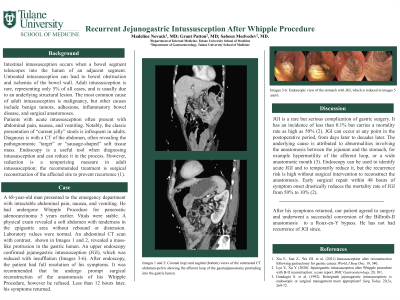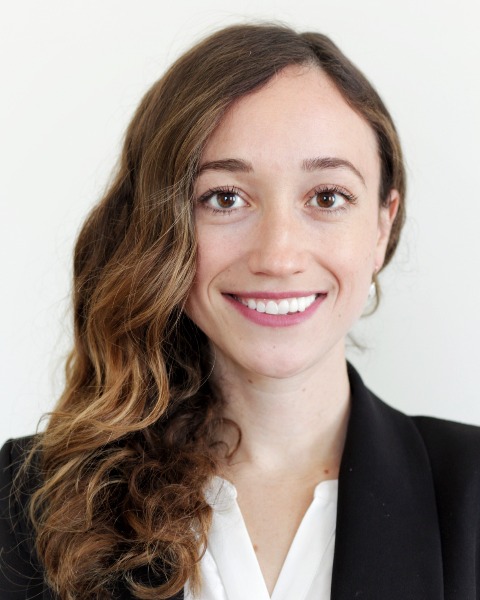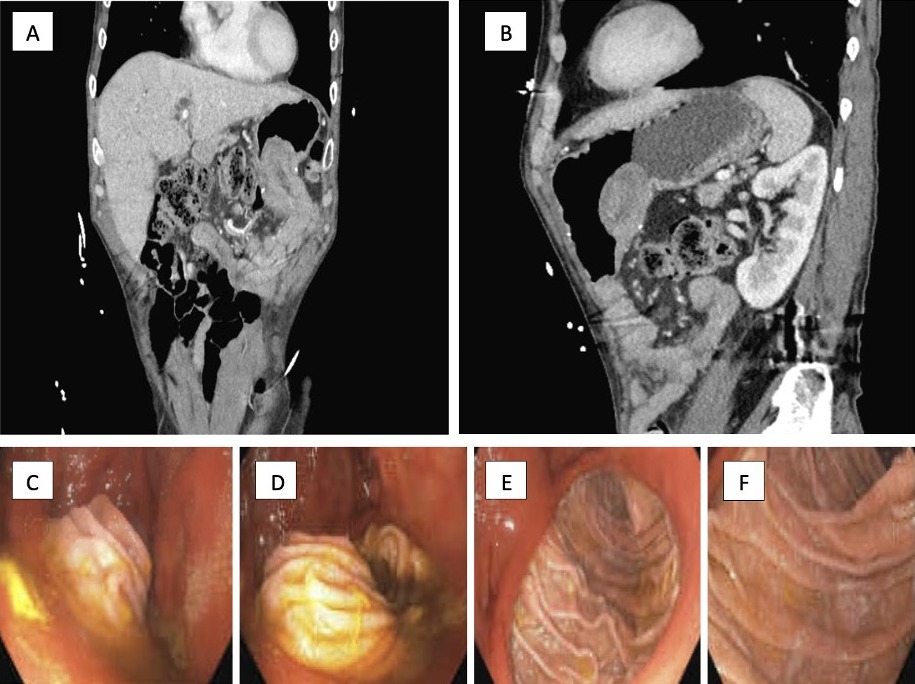Monday Poster Session
Category: General Endoscopy
P2021 - Recurrent Jejunogastric Intussusception After Whipple Procedure
Monday, October 23, 2023
10:30 AM - 4:15 PM PT
Location: Exhibit Hall

Has Audio

Madeline Novack, MD
Tulane University School of Medicine
New Orleans, LA
Presenting Author(s)
Madeline Novack, MD1, Grant Patton, MD1, Sabeen F. Medvedev, MD2
1Tulane University School of Medicine, New Orleans, LA; 2Southeastern Louisiana Veterans Health Care New Orleans, New Orleans, LA
Introduction: Intestinal intussusception occurs when a bowel segment telescopes into the lumen of an adjacent segment. Untreated intussusception can lead to bowel obstruction and ischemia of the bowel wall. Intussusception is rare in adults, representing only 5% of all cases, but is a life-threatening condition. Adult intussusception is often due to malignancy, but other causes include benign tumors, adhesions, inflammatory bowel disease, and surgical anastomoses. Jejunogastric intussusception (JGI) is a rare but serious complication of gastric surgery and carries a mortality rate as high as 50%. The recommended treatment is surgical reconstruction of the affected site to prevent recurrence. This case describes the utility of endoscopy to diagnose and reduce JGI. It also highlights the importance of surgical repair as the definitive management.
Case Description/Methods: A 68-year-old man presented to the emergency department with intractable abdominal pain, nausea, and vomiting. He had undergone a Whipple Procedure for pancreatic adenocarcinoma five years earlier. A physical exam revealed stable vitals and a soft abdomen with tenderness in the epigastric area without rebound or distension. An abdominal CT scan revealed a masslike protrusion in the gastric lumen. Upper endoscopy showed JGI, which was reduced with insufflation. After the endoscopy, the patient had full resolution of his symptoms. It was recommended that he undergo prompt surgical reconstruction of the anastomosis of his Whipple Procedure, however, he refused. Less than twelve hours later, his symptoms returned. He underwent a successful conversion of the anastomosis to a Roux-en-Y bypass and has not had a recurrence of JGI since.
Discussion: JGI after gastric surgery can occur at any point in the postoperative period, from days to decades later. It carries a high mortality rate if not addressed surgically. Endoscopy can be a useful tool when diagnosing and reducing non-malignant intussusception, and some case reports have even described endoscopy alone as a potential conservative approach to intussusception. However, in the presence of a lead point like a previous surgical anastomosis, the recurrence risk of JGI is high and requires prompt surgical repair.

Disclosures:
Madeline Novack, MD1, Grant Patton, MD1, Sabeen F. Medvedev, MD2. P2021 - Recurrent Jejunogastric Intussusception After Whipple Procedure, ACG 2023 Annual Scientific Meeting Abstracts. Vancouver, BC, Canada: American College of Gastroenterology.
1Tulane University School of Medicine, New Orleans, LA; 2Southeastern Louisiana Veterans Health Care New Orleans, New Orleans, LA
Introduction: Intestinal intussusception occurs when a bowel segment telescopes into the lumen of an adjacent segment. Untreated intussusception can lead to bowel obstruction and ischemia of the bowel wall. Intussusception is rare in adults, representing only 5% of all cases, but is a life-threatening condition. Adult intussusception is often due to malignancy, but other causes include benign tumors, adhesions, inflammatory bowel disease, and surgical anastomoses. Jejunogastric intussusception (JGI) is a rare but serious complication of gastric surgery and carries a mortality rate as high as 50%. The recommended treatment is surgical reconstruction of the affected site to prevent recurrence. This case describes the utility of endoscopy to diagnose and reduce JGI. It also highlights the importance of surgical repair as the definitive management.
Case Description/Methods: A 68-year-old man presented to the emergency department with intractable abdominal pain, nausea, and vomiting. He had undergone a Whipple Procedure for pancreatic adenocarcinoma five years earlier. A physical exam revealed stable vitals and a soft abdomen with tenderness in the epigastric area without rebound or distension. An abdominal CT scan revealed a masslike protrusion in the gastric lumen. Upper endoscopy showed JGI, which was reduced with insufflation. After the endoscopy, the patient had full resolution of his symptoms. It was recommended that he undergo prompt surgical reconstruction of the anastomosis of his Whipple Procedure, however, he refused. Less than twelve hours later, his symptoms returned. He underwent a successful conversion of the anastomosis to a Roux-en-Y bypass and has not had a recurrence of JGI since.
Discussion: JGI after gastric surgery can occur at any point in the postoperative period, from days to decades later. It carries a high mortality rate if not addressed surgically. Endoscopy can be a useful tool when diagnosing and reducing non-malignant intussusception, and some case reports have even described endoscopy alone as a potential conservative approach to intussusception. However, in the presence of a lead point like a previous surgical anastomosis, the recurrence risk of JGI is high and requires prompt surgical repair.

Figure: Images A and B are coronal (A) and sagittal (B) views of the contrasted CT scan of the abdomen and pelvis showing the efferent loop of the gastrojejunostomy protruding into the gastric lumen.
Images C and D are endoscopic views of the JGI. Images E and F are endoscopic views after the JGI was reduced with insufflation.
Images C and D are endoscopic views of the JGI. Images E and F are endoscopic views after the JGI was reduced with insufflation.
Disclosures:
Madeline Novack indicated no relevant financial relationships.
Grant Patton indicated no relevant financial relationships.
Sabeen Medvedev indicated no relevant financial relationships.
Madeline Novack, MD1, Grant Patton, MD1, Sabeen F. Medvedev, MD2. P2021 - Recurrent Jejunogastric Intussusception After Whipple Procedure, ACG 2023 Annual Scientific Meeting Abstracts. Vancouver, BC, Canada: American College of Gastroenterology.

